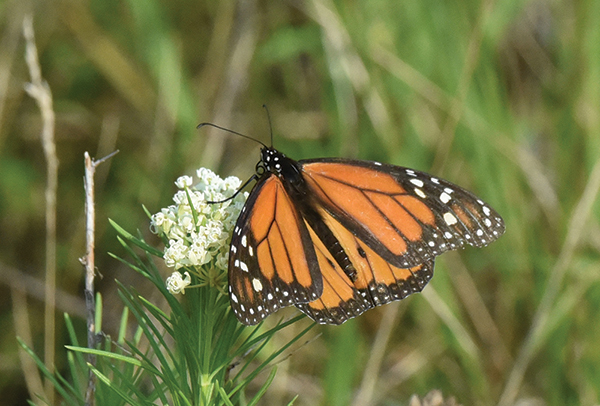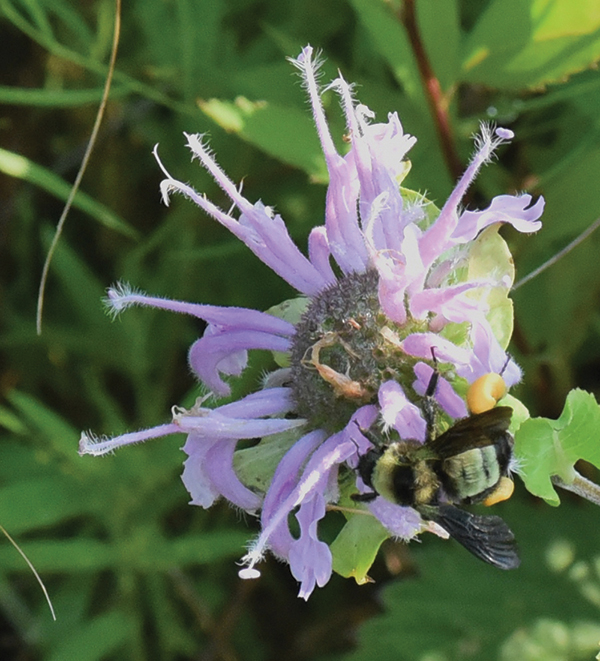Nectar everywhere…and insects will find it

T-R PHOTOS BY GARRY BRANDENBURG - A short hike earlier this week into the Marietta Sand Prairie was an interesting exploration into the life of miniature animals ... insects. It did not take long to find several varieties of long-legged critters, all with wings, and all very busy at their work sipping at and gathering nectar from various plant flowers.
INSECTS are plentiful, sometimes a pest, however for the most part are underappreciated for the good things they do. If us humans like to eat a wide variety of nutritious foods, we must acknowledge the role beneficial insects play in creating those foods. Three-fourths of the world’s plant species that contribute to food supplies require pollination. Pollination in many instances can be obtained by a huge variety of insects flying about, day or night, visiting the flowers of all kinds of plants, and passing along pollen grains. An estimated $200 billion dollars worth of crop species are pollinated by insects.
Pollination of plants is not restricted to just insects. Wind works well for some plants. Water can be a transport method for pollen in other instances whereby some plant products float on the surface and interact with other plant parts. A variation of water assisting in pollination is rain, whereby splashing water takes with its raindrops small portions of pollen. For some orchids, rain allows self-pollination. Small mammals such as mice or voles, may unwittingly transport pollen collected on their fur as they scurry along ground runs and brush against low growing flower parts of plants. Flying mammals, bats in this instance, also conduct a lot of pollination while flying at night in ecosystems where desert flowers only open at night. Night time visits to flowers allows bats to eat, and distribute pollen from plant to plant in the process.
Animals, insects and small mammals, carry pollen grains from the anther of one flower to the receptive part of the carpel or pistil (stigma) of another flower. Between 100,000, and 200,000 species of animal act as pollinators of the world’s 250,000 species of flowering plants.
The majority of these animals are insects, but about 1,500 species of birds and mammal visits to flowers may transfer pollen. In some ecosystems of earth, monkeys, lemurs, squirrels, rodents and opossums play a role in plant life continuation.
Flowers may look one color to our human eyes. To the eyes of birds, and eyes of insects, flower color may transmit wavelengths of light invisible to us, but very visible to them. Color helps. So does fragrant scents to help attract insects in unerring flights to and from flowers. In today’s images of insects at work, note how the bumblebee working over a blossom of Wild Bergamot, has its hind legs packed with pollen. It may be hard to see, but the pollen packets are there, ready to be transported back to the ground burrow hive. A Common Sulphur butterfly conducts its feeding and pollination on a clover blossom. And a Monarch butterfly and black wasp take their turns on tiny white flowers. Among other flying insects one might find on flowers are bees, wasps, ants, beetles, moths, butterflies and flies.

T-R PHOTOS BY GARRY BRANDENBURG - A short hike earlier this week into the Marietta Sand Prairie was an interesting exploration into the life of miniature animals....insects. It did not take long to find several varieties of long-legged critters, all with wings, and all very busy at their work sipping at and gathering nectar from various plant flowers.
Honey bees are extremely valuable for crops. In fact, full semi loads of hives may be transported across the nation in timely manners to facilitate fruit tree flowering times. The largest managed pollination event involves California almond orchards, where nearly half of all honey bee hives (about one million hives) are trucked to almond orchards each spring. It is estimated that it takes 30,000 hives in New York state to help pollinate apple crops. Maine’s blueberry crops require 50,000 hives. An incentive to create long term conservation plots involves all kinds of native flower varieties specifically for encouraging natural and native insects to thrive so that pollination can be more effective.
Prairie flowers at the Marietta Sand Prairie are great to look at and admire. While us humans may have one motive just to see and admire all the grassland native plants, at our feet as we pass by is the tiny world of insects going about their work of living. And their life depends on finding food for themselves while allowing all kinds of host plants to thrive as pollen exchanges make those flowering plants viable for another year. Mother Nature has a fine tuned system in place. Our task is to appreciate and marvel at this intricate web of life. Enjoy your hikes into the Sand Prairie.
TIME SPENT OUTDOORS is refreshing. Time spent with nature as your guide is exhilarating and in many subtle ways instructive. My morning hike into the Sand Prairie, as noted above, accomplished as much for me personally as it did for finding fodder for this article. I knew in advance I could find subjects to photograph, to learn about, and then provide highlights for you to read about. Mission accomplished.
An evolutionary biologist explained on his podcast how studies have shown that one of the best ways to boost mental health involves exercise….and….to get that exercise in places of natural settings such as parks, trails, lakeside fishing adventures, or to walk under tall trees. Getting outside is one way to detach oneself from computers, cell phones and human induced things we think we have to do. Mother Nature has an recipe for mental health enhancement. It involves getting outside doing things you like to do, in setting devoid of hard structured work. I think those items are just what the doctor ordered for anyone willing to spend time fishing, hiking, hunting, camping, bird watching, or other outdoor endeavor. May Mother Nature’s force be with you. Enjoy.
DEER LICENSE SALES begin today, at vendor locations, or online. Iowa deer licenses for this fall 0f 2021 and into January of 2022 need to be purchased prior to any opening of youth deer seasons, or regular archery and/or following gun seasons. Iowa deer numbers for the population as a whole across Iowa are in line with biologist’s forecasts. The new 2021-22 hunting regulations booklet from the Iowa DNR has been printed. They are now available at license outlets, or if you attend the Iowa State Fair, at the DNR building where all the fish aquariums draw throngs of visitors to see what lives under the waters of Iowa. It will not be long before sportsmen and women will feel the unique urge to prepare for fall hunting seasons.

T-R PHOTO BY GARRY BRANDENBURG - Summer is a busy time for insects since a major portion of their entire life cycle depends upon food finding. And in these cases, finding foods is also part of a long and complicated ecological interaction between plants and insects to distribute pollen for the propagation of many different plants. Insects may be tiny, but they are integral to plant life, and essential for all kinds of food production.
ROADSIDE WILDLIFE COUNTS ROUTES have been completed in most of Iowa’s 200 plus routes. For Tyson Brown, game warden, his routes were accomplished and data sent into the biologist’s office for tabulation. On one of his routes, he observed 31 gray partridge, 12 pheasants and 1 rabbit. These numbers by themselves may not appear to be trend setting, but over time of many past years, these numbers can show trends of overall populations. In September, all statewide upland game route data will be published. From that relative population maps can be made for pheasants, quail, partridge and cottontail rabbits.
During these turbulent times in the world, remember this quote from Booker T. Washington. “A lie doesn’t become truth. wrong doesn’t become right, and evil doesn’t become good just because it’s accepted by the majority.”
——
Garry Brandenburg is the retired director of the Marshall County Conservation Board. He is a graduate of Iowa State University with a BS degree in Fish & Wildlife Biology.
Contact him at:
P.O. Box 96
Albion, IA 50005
- T-R PHOTOS BY GARRY BRANDENBURG – A short hike earlier this week into the Marietta Sand Prairie was an interesting exploration into the life of miniature animals … insects. It did not take long to find several varieties of long-legged critters, all with wings, and all very busy at their work sipping at and gathering nectar from various plant flowers.
- T-R PHOTOS BY GARRY BRANDENBURG – A short hike earlier this week into the Marietta Sand Prairie was an interesting exploration into the life of miniature animals….insects. It did not take long to find several varieties of long-legged critters, all with wings, and all very busy at their work sipping at and gathering nectar from various plant flowers.
- T-R PHOTO BY GARRY BRANDENBURG – Summer is a busy time for insects since a major portion of their entire life cycle depends upon food finding. And in these cases, finding foods is also part of a long and complicated ecological interaction between plants and insects to distribute pollen for the propagation of many different plants. Insects may be tiny, but they are integral to plant life, and essential for all kinds of food production.









